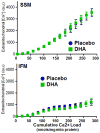Evaluation of docosahexaenoic acid in a dog model of hypertension induced left ventricular hypertrophy
- PMID: 24065618
- PMCID: PMC4793776
- DOI: 10.1007/s12265-013-9511-y
Evaluation of docosahexaenoic acid in a dog model of hypertension induced left ventricular hypertrophy
Abstract
Marine n-3 polyunsaturated fatty acids alter cardiac phospholipids and prevent cardiac pathology in rodents subjected to pressure overload. This approach has not been evaluated in humans or large animals with hypertension-induced pathological hypertrophy. We evaluated docosahexaenoic acid (DHA) in old female dogs with hypertension caused by 16 weeks of aldosterone infusion. Aldosterone-induced hypertension resulted in concentric left ventricular (LV) hypertrophy and impaired diastolic function in placebo-treated dogs. DHA supplementation increased DHA and depleted arachidonic acid in cardiac phospholipids, but did not improve LV parameters compared to placebo. Surprisingly, DHA significantly increased serum aldosterone concentration and blood pressure compared to placebo. Cardiac mitochondrial yield was decreased in placebo-treated hypertensive dogs compared to normal animals, which was prevented by DHA. Extensive analysis of mitochondrial function found no differences between DHA and placebo groups. In conclusion, DHA did not favorably impact mitochondrial or LV function in aldosterone hypertensive dogs.
Figures






Similar articles
-
Docosahexaenoic acid supplementation alters key properties of cardiac mitochondria and modestly attenuates development of left ventricular dysfunction in pressure overload-induced heart failure.Cardiovasc Drugs Ther. 2013 Dec;27(6):499-510. doi: 10.1007/s10557-013-6487-4. Cardiovasc Drugs Ther. 2013. PMID: 24013804 Free PMC article.
-
The cardioprotective effects of fish oil during pressure overload are blocked by high fat intake: role of cardiac phospholipid remodeling.Hypertension. 2009 Sep;54(3):605-11. doi: 10.1161/HYPERTENSIONAHA.109.135806. Epub 2009 Jul 13. Hypertension. 2009. PMID: 19597033 Free PMC article.
-
Feeding Docosahexaenoic Acid and Arachidonic Acid during Suckling and Weaning Contributes to Oral Tolerance Development by Beneficially Modulating the Intestinal Cytokine and Immunoglobulin Levels in an Allergy-Prone Brown Norway Rat Model.J Nutr. 2024 Dec;154(12):3790-3802. doi: 10.1016/j.tjnut.2024.10.021. Epub 2024 Oct 12. J Nutr. 2024. PMID: 39401683
-
Dietary supplements for preventing postnatal depression.Cochrane Database Syst Rev. 2013 Oct 24;2013(10):CD009104. doi: 10.1002/14651858.CD009104.pub2. Cochrane Database Syst Rev. 2013. PMID: 24158923 Free PMC article.
-
Eplerenone for hypertension.Cochrane Database Syst Rev. 2017 Feb 28;2(2):CD008996. doi: 10.1002/14651858.CD008996.pub2. Cochrane Database Syst Rev. 2017. PMID: 28245343 Free PMC article.
Cited by
-
Effect of a diet enriched with omega-6 and omega-3 fatty acids on the pig liver transcriptome.Genes Nutr. 2016 Mar 17;11:9. doi: 10.1186/s12263-016-0517-4. eCollection 2016. Genes Nutr. 2016. PMID: 27482299 Free PMC article.
-
Omega-3 fatty acid prevents the development of heart failure by changing fatty acid composition in the heart.Sci Rep. 2020 Sep 23;10(1):15553. doi: 10.1038/s41598-020-72686-0. Sci Rep. 2020. PMID: 32968201 Free PMC article.
-
Dietary Docosahexaenoic Acid Reduces Oscillatory Wall Shear Stress, Atherosclerosis, and Hypertension, Most Likely Mediated via an IL-1-Mediated Mechanism.J Am Heart Assoc. 2018 Jun 30;7(13):e008757. doi: 10.1161/JAHA.118.008757. J Am Heart Assoc. 2018. PMID: 29960988 Free PMC article.
-
Association of dietary fatty acids and the incidence risk of cardiovascular disease in adults: the Tehran Lipid and Glucose Prospective Study.BMC Public Health. 2020 Nov 19;20(1):1743. doi: 10.1186/s12889-020-09824-w. BMC Public Health. 2020. PMID: 33213372 Free PMC article.
-
MitoQ improves mitochondrial dysfunction in heart failure induced by pressure overload.Free Radic Biol Med. 2018 Mar;117:18-29. doi: 10.1016/j.freeradbiomed.2018.01.012. Epub 2018 Feb 2. Free Radic Biol Med. 2018. PMID: 29421236 Free PMC article.
References
-
- Moertl D, Hammer A, Steiner S, Hutuleac R, Vonbank K, Berger R. Dose-dependent effects of omega-3-polyunsaturated fatty acids on systolic left ventricular function, endothelial function, and markers of inflammation in chronic heart failure of nonischemic origin: a double-blind, placebo-controlled, 3-arm study. Am Heart J. 2011;161:915–919. doi: 10.1016/j.ahj.2011.02.011. S0002-8703(11)00164-5 [pii] - DOI - PubMed
-
- Nodari S, Triggiani M, Campia U, Manerba A, Milesi G, Cesana BM, Gheorghiade M, Dei CL. Effects of n-3 Polyunsaturated Fatty Acids on Left Ventricular Function and Functional Capacity in Patients With Dilated Cardiomyopathy. J Am Coll Cardiol. 2011;57:870–879. - PubMed
-
- Gissi-Hf I. Effect of n-3 polyunsaturated fatty acids in patients with chronic heart failure (the GISSI-HF trial): a randomised, double-blind, placebo-controlled trial. Lancet. 2008;372:1223–1230. - PubMed
Publication types
MeSH terms
Substances
Grants and funding
LinkOut - more resources
Full Text Sources
Other Literature Sources
Medical

